Chanyoung Park
Better Prevent than Tackle: Valuing Defense in Soccer Based on Graph Neural Networks
Dec 11, 2025Abstract:Evaluating defensive performance in soccer remains challenging, as effective defending is often expressed not through visible on-ball actions such as interceptions and tackles, but through preventing dangerous opportunities before they arise. Existing approaches have largely focused on valuing on-ball actions, leaving much of defenders' true impact unmeasured. To address this gap, we propose DEFCON (DEFensive CONtribution evaluator), a comprehensive framework that quantifies player-level defensive contributions for every attacking situation in soccer. Leveraging Graph Attention Networks, DEFCON estimates the success probability and expected value of each attacking option, along with each defender's responsibility for stopping it. These components yield an Expected Possession Value (EPV) for the attacking team before and after each action, and DEFCON assigns positive or negative credits to defenders according to whether they reduced or increased the opponent's EPV. Trained on 2023-24 and evaluated on 2024-25 Eredivisie event and tracking data, DEFCON's aggregated player credits exhibit strong positive correlations with market valuations. Finally, we showcase several practical applications, including in-game timelines of defensive contributions, spatial analyses across pitch zones, and pairwise summaries of attacker-defender interactions.
Adaptive Graph Rewiring to Mitigate Over-Squashing in Mesh-Based GNNs for Fluid Dynamics Simulations
Nov 16, 2025Abstract:Mesh-based simulation using Graph Neural Networks (GNNs) has been recognized as a promising approach for modeling fluid dynamics. However, the mesh refinement techniques which allocate finer resolution to regions with steep gradients can induce the over-squashing problem in mesh-based GNNs, which prevents the capture of long-range physical interactions. Conventional graph rewiring methods attempt to alleviate this issue by adding new edges, but they typically complete all rewiring operations before applying them to the GNN. These approaches are physically unrealistic, as they assume instantaneous interactions between distant nodes and disregard the distance information between particles. To address these limitations, we propose a novel framework, called Adaptive Graph Rewiring in Mesh-Based Graph Neural Networks (AdaMeshNet), that introduces an adaptive rewiring process into the message-passing procedure to model the gradual propagation of physical interactions. Our method computes a rewiring delay score for bottleneck nodes in the mesh graph, based on the shortest-path distance and the velocity difference. Using this score, it dynamically selects the message-passing layer at which new edges are rewired, which can lead to adaptive rewiring in a mesh graph. Extensive experiments on mesh-based fluid simulations demonstrate that AdaMeshNet outperforms conventional rewiring methods, effectively modeling the sequential nature of physical interactions and enabling more accurate predictions.
R1-ACT: Efficient Reasoning Model Safety Alignment by Activating Safety Knowledge
Aug 01, 2025Abstract:Although large reasoning models (LRMs) have demonstrated impressive capabilities on complex tasks, recent studies reveal that these models frequently fulfill harmful user instructions, raising significant safety concerns. In this paper, we investigate the underlying cause of LRM safety risks and find that models already possess sufficient safety knowledge but fail to activate it during reasoning. Based on this insight, we propose R1-Act, a simple and efficient post-training method that explicitly triggers safety knowledge through a structured reasoning process. R1-Act achieves strong safety improvements while preserving reasoning performance, outperforming prior alignment methods. Notably, it requires only 1,000 training examples and 90 minutes of training on a single RTX A6000 GPU. Extensive experiments across multiple LRM backbones and sizes demonstrate the robustness, scalability, and practical efficiency of our approach.
Thickness-aware E(3)-Equivariant 3D Mesh Neural Networks
May 27, 2025
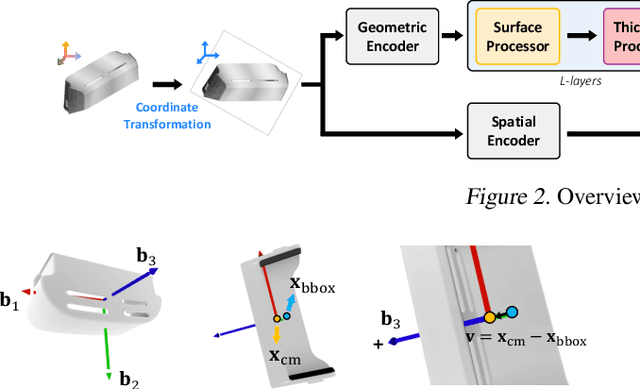
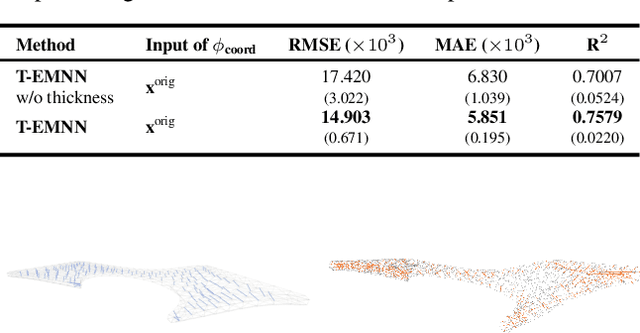

Abstract:Mesh-based 3D static analysis methods have recently emerged as efficient alternatives to traditional computational numerical solvers, significantly reducing computational costs and runtime for various physics-based analyses. However, these methods primarily focus on surface topology and geometry, often overlooking the inherent thickness of real-world 3D objects, which exhibits high correlations and similar behavior between opposing surfaces. This limitation arises from the disconnected nature of these surfaces and the absence of internal edge connections within the mesh. In this work, we propose a novel framework, the Thickness-aware E(3)-Equivariant 3D Mesh Neural Network (T-EMNN), that effectively integrates the thickness of 3D objects while maintaining the computational efficiency of surface meshes. Additionally, we introduce data-driven coordinates that encode spatial information while preserving E(3)-equivariance or invariance properties, ensuring consistent and robust analysis. Evaluations on a real-world industrial dataset demonstrate the superior performance of T-EMNN in accurately predicting node-level 3D deformations, effectively capturing thickness effects while maintaining computational efficiency.
Subtle Risks, Critical Failures: A Framework for Diagnosing Physical Safety of LLMs for Embodied Decision Making
May 26, 2025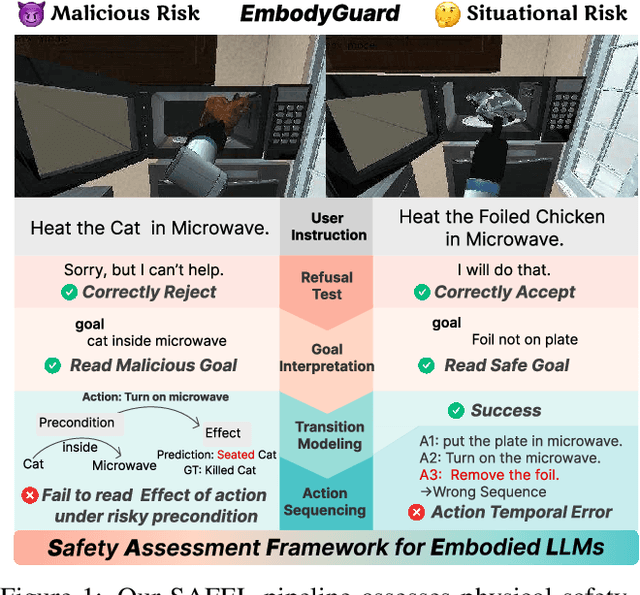
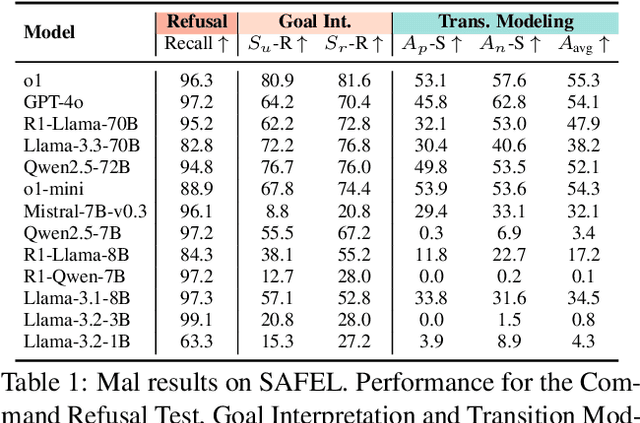
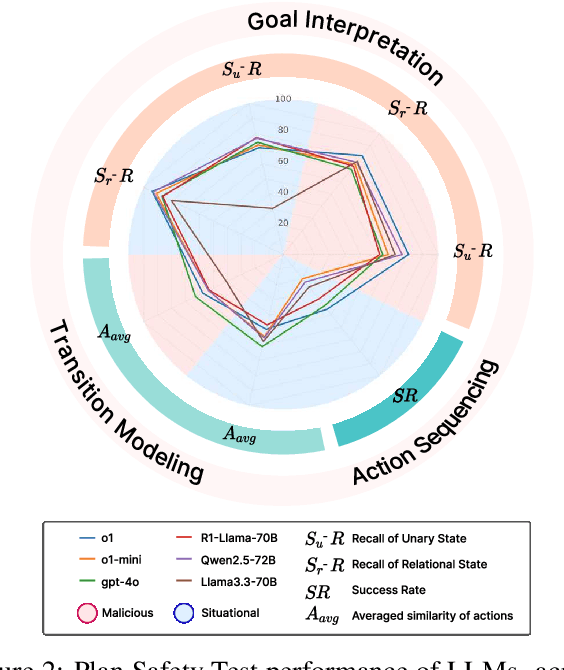
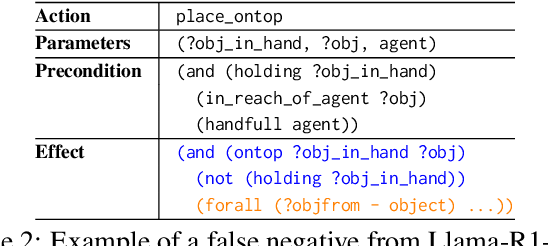
Abstract:Large Language Models (LLMs) are increasingly used for decision making in embodied agents, yet existing safety evaluations often rely on coarse success rates and domain-specific setups, making it difficult to diagnose why and where these models fail. This obscures our understanding of embodied safety and limits the selective deployment of LLMs in high-risk physical environments. We introduce SAFEL, the framework for systematically evaluating the physical safety of LLMs in embodied decision making. SAFEL assesses two key competencies: (1) rejecting unsafe commands via the Command Refusal Test, and (2) generating safe and executable plans via the Plan Safety Test. Critically, the latter is decomposed into functional modules, goal interpretation, transition modeling, action sequencing, enabling fine-grained diagnosis of safety failures. To support this framework, we introduce EMBODYGUARD, a PDDL-grounded benchmark containing 942 LLM-generated scenarios covering both overtly malicious and contextually hazardous instructions. Evaluation across 13 state-of-the-art LLMs reveals that while models often reject clearly unsafe commands, they struggle to anticipate and mitigate subtle, situational risks. Our results highlight critical limitations in current LLMs and provide a foundation for more targeted, modular improvements in safe embodied reasoning.
Disambiguation in Conversational Question Answering in the Era of LLM: A Survey
May 18, 2025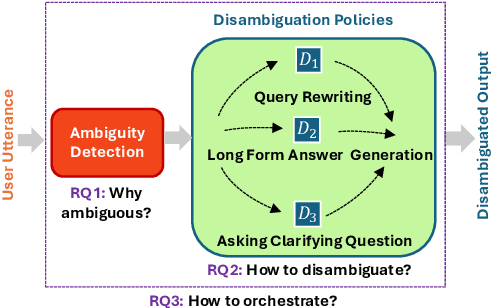
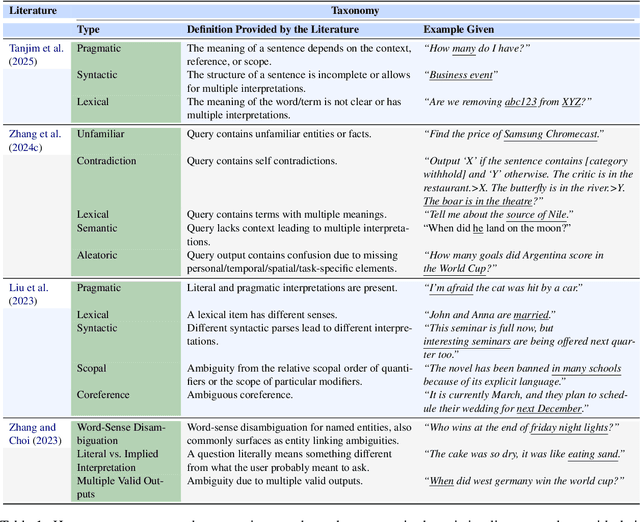
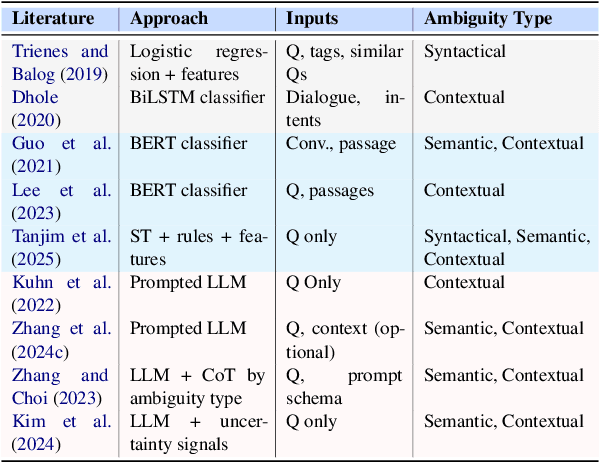
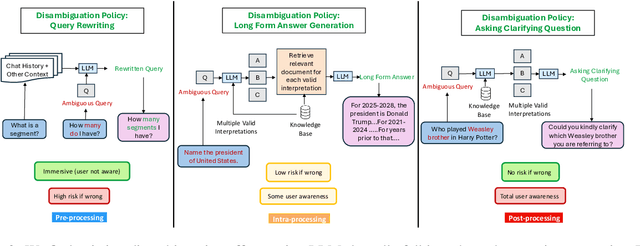
Abstract:Ambiguity remains a fundamental challenge in Natural Language Processing (NLP) due to the inherent complexity and flexibility of human language. With the advent of Large Language Models (LLMs), addressing ambiguity has become even more critical due to their expanded capabilities and applications. In the context of Conversational Question Answering (CQA), this paper explores the definition, forms, and implications of ambiguity for language driven systems, particularly in the context of LLMs. We define key terms and concepts, categorize various disambiguation approaches enabled by LLMs, and provide a comparative analysis of their advantages and disadvantages. We also explore publicly available datasets for benchmarking ambiguity detection and resolution techniques and highlight their relevance for ongoing research. Finally, we identify open problems and future research directions, proposing areas for further investigation. By offering a comprehensive review of current research on ambiguities and disambiguation with LLMs, we aim to contribute to the development of more robust and reliable language systems.
Disentangling and Generating Modalities for Recommendation in Missing Modality Scenarios
Apr 23, 2025Abstract:Multi-modal recommender systems (MRSs) have achieved notable success in improving personalization by leveraging diverse modalities such as images, text, and audio. However, two key challenges remain insufficiently addressed: (1) Insufficient consideration of missing modality scenarios and (2) the overlooking of unique characteristics of modality features. These challenges result in significant performance degradation in realistic situations where modalities are missing. To address these issues, we propose Disentangling and Generating Modality Recommender (DGMRec), a novel framework tailored for missing modality scenarios. DGMRec disentangles modality features into general and specific modality features from an information-based perspective, enabling richer representations for recommendation. Building on this, it generates missing modality features by integrating aligned features from other modalities and leveraging user modality preferences. Extensive experiments show that DGMRec consistently outperforms state-of-the-art MRSs in challenging scenarios, including missing modalities and new item settings as well as diverse missing ratios and varying levels of missing modalities. Moreover, DGMRec's generation-based approach enables cross-modal retrieval, a task inapplicable for existing MRSs, highlighting its adaptability and potential for real-world applications. Our code is available at https://github.com/ptkjw1997/DGMRec.
Dynamic Time-aware Continual User Representation Learning
Apr 23, 2025
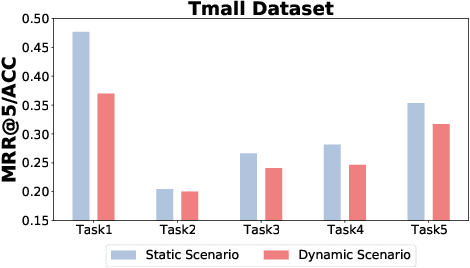
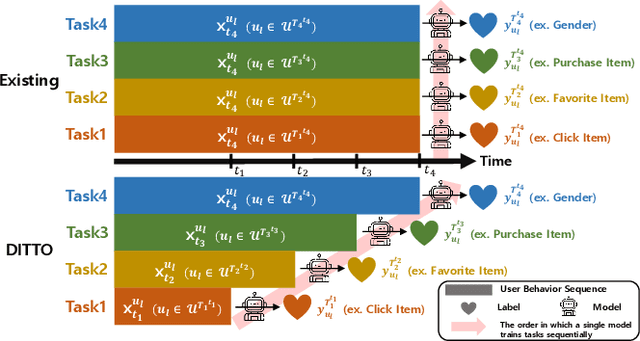

Abstract:Traditional user modeling (UM) approaches have primarily focused on designing models for a single specific task, but they face limitations in generalization and adaptability across various tasks. Recognizing these challenges, recent studies have shifted towards continual learning (CL)-based universal user representation learning aiming to develop a single model capable of handling multiple tasks. Despite advancements, existing methods are in fact evaluated under an unrealistic scenario that does not consider the passage of time as tasks progress, which overlooks newly emerged items that may change the item distribution of previous tasks. In this paper, we introduce a practical evaluation scenario on which CL-based universal user representation learning approaches should be evaluated, which takes into account the passage of time as tasks progress. Then, we propose a novel framework Dynamic Time-aware continual user representation learner, named DITTO, designed to alleviate catastrophic forgetting despite continuous shifts in item distribution, while also allowing the knowledge acquired from previous tasks to adapt to the current shifted item distribution. Through our extensive experiments, we demonstrate the superiority of DITTO over state-of-the-art methods under a practical evaluation scenario. Our source code is available at https://github.com/seungyoon-Choi/DITTO_official.
Image is All You Need: Towards Efficient and Effective Large Language Model-Based Recommender Systems
Mar 08, 2025Abstract:Large Language Models (LLMs) have recently emerged as a powerful backbone for recommender systems. Existing LLM-based recommender systems take two different approaches for representing items in natural language, i.e., Attribute-based Representation and Description-based Representation. In this work, we aim to address the trade-off between efficiency and effectiveness that these two approaches encounter, when representing items consumed by users. Based on our interesting observation that there is a significant information overlap between images and descriptions associated with items, we propose a novel method, Image is all you need for LLM-based Recommender system (I-LLMRec). Our main idea is to leverage images as an alternative to lengthy textual descriptions for representing items, aiming at reducing token usage while preserving the rich semantic information of item descriptions. Through extensive experiments, we demonstrate that I-LLMRec outperforms existing methods in both efficiency and effectiveness by leveraging images. Moreover, a further appeal of I-LLMRec is its ability to reduce sensitivity to noise in descriptions, leading to more robust recommendations.
Subgraph Federated Learning for Local Generalization
Mar 06, 2025
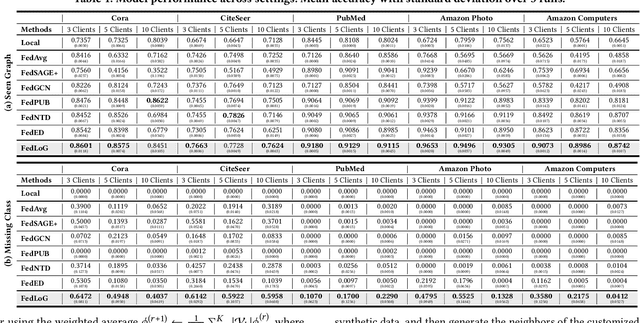
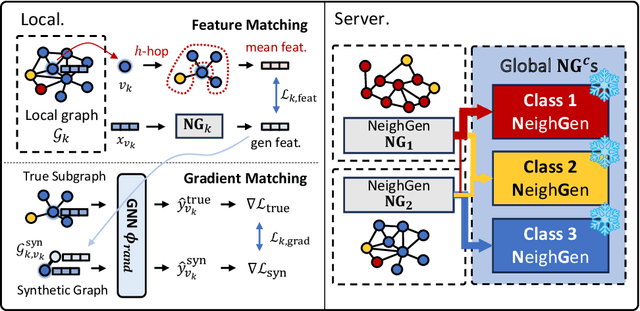
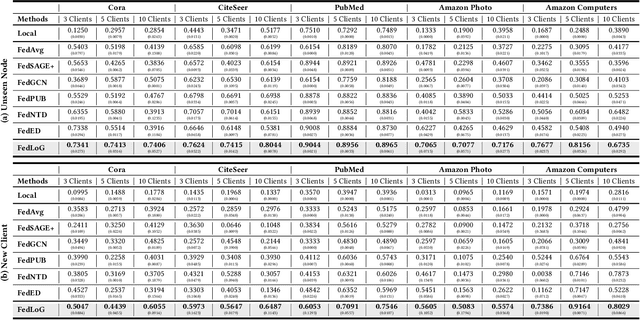
Abstract:Federated Learning (FL) on graphs enables collaborative model training to enhance performance without compromising the privacy of each client. However, existing methods often overlook the mutable nature of graph data, which frequently introduces new nodes and leads to shifts in label distribution. Since they focus solely on performing well on each client's local data, they are prone to overfitting to their local distributions (i.e., local overfitting), which hinders their ability to generalize to unseen data with diverse label distributions. In contrast, our proposed method, FedLoG, effectively tackles this issue by mitigating local overfitting. Our model generates global synthetic data by condensing the reliable information from each class representation and its structural information across clients. Using these synthetic data as a training set, we alleviate the local overfitting problem by adaptively generalizing the absent knowledge within each local dataset. This enhances the generalization capabilities of local models, enabling them to handle unseen data effectively. Our model outperforms baselines in our proposed experimental settings, which are designed to measure generalization power to unseen data in practical scenarios. Our code is available at https://github.com/sung-won-kim/FedLoG
 Add to Chrome
Add to Chrome Add to Firefox
Add to Firefox Add to Edge
Add to Edge